Seattle’s seawall project using 190 tons of discarded shells as marine habitat
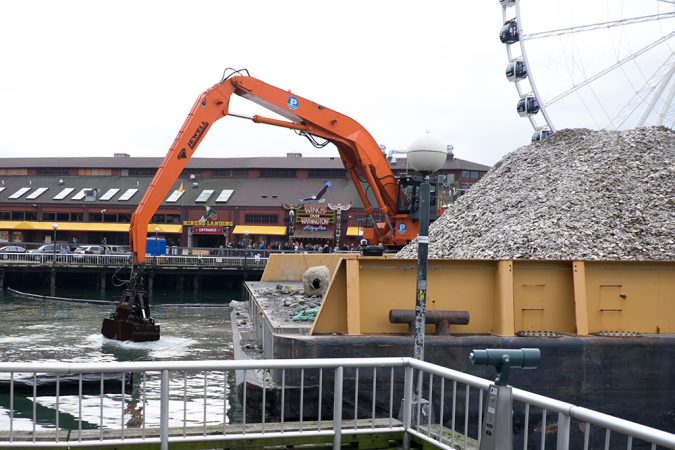
Three hundred and eighty yards of oyster shells, weighing 1,000 pounds each, just became an integral part of Seattle’s shoreline. As the city rebuilds the seawall that separates its famous Downtown waterfront – lined with seafood restaurants, markets, skyscrapers and tourist attractions – from the waters of Puget Sound, it turned to this abundant bivalve byproduct for a unique, environmentally friendly material to make a sustainable, hospitable marine habitat.
The project, which will open 20 acres of new and remodeled public space along the shoreline corridor, is replacing the previous seawall, which was constructed with the Alaskan Way Viaduct (a raised roadway slated now slated for demolition), 20,000 old-growth timber piles and a concrete wall.
In building the new barrier, which should be finished mid-2017, the city looked for design and materials as pragmatic and beneficial for its underwater residents as for those using the parks, paths and services above ground.
People get it that shellfish is great food and creates valuable jobs, but they don’t always grasp the ecosystem services that shellfish provide
Using discarded oyster shells from Taylor Shellfish Farms in nearby Shelton, Wash., the city aims to bring in and sustain the aquatic life surrounding the 18-month construction project. In planning the wall and habitat bench – a habitat enhancement and extension of the seawall 150 feet out into the water – the city requested oyster shells as the material (along with pea gravel).
“Honestly, it’s the first thing we thought of as a material that might be both a byproduct and available in a large-enough quantity,” said John Currier of Pacific Pile & Marine, the company constructing this section of the project.
The shell and gravel mix is stuffed into plastic mesh bags to become marine mattresses, which are then placed underneath the newly constructed light-permeable sidewalk. There, marine life will cling to the substrate within the mattresses, providing an ideal habitat for other types of sea creatures, including the iconic spawning salmon of the Pacific Northwest.
But acquiring 190 tons of oyster shell was no sure thing: Taylor Shellfish doesn’t often sell its shells, since it mostly uses them internally to reseed and grow the next generation of baby oysters. However, the farm – in operation since 1890 – understands the long-term benefits for the entire Puget Sound watershed.
“We get inquiries all the time, but usually from landscapers or the agricultural industry,” said the company’s farm project coordinator Nyle Taylor. They ended up giving a rare approval for this project because it fit with the company’s goal of helping with habitat reconstruction, and the shells would be a part of improving Elliott Bay.
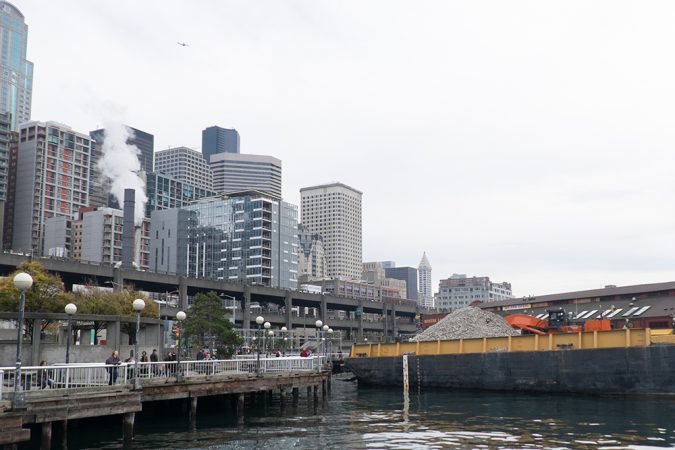
“We put a lot of time and effort into water quality and environmental protection,” said Bill Dewey, Taylor’s director of public affairs, which includes making their own farming operations sustainable in addition to working with others to produce a healthy ecosystem.
“I like to promote the ecological services that shellfish provides,” continued Dewey. “A lot of people don’t fully understand that. They get it that shellfish is great food and creates valuable jobs, but they don’t always grasp the ecosystem services that shellfish provide.”
Both dead and alive, oysters have a long history of deployment for this type of project: One of his favorite slides for presentations, said Dewey, is a photo of a boat in New York City Harbor spraying oysters into the waters around the Statue of Liberty.
“All those filter feeders, providing that filtration service there in the harbor,” Dewey said, are creating an oyster reef, for many of the same reasons Seattle is building with shell on its seawall.
In early November on Pier 59 – situated between the Great Wheel and the Seattle Aquarium – when tourists milled about and locals walked by purposefully, nobody seemed to have any idea that 190 tons of oyster shells were about to make the water below them a better home for sea life. Perhaps it was because it’s not the people who need to know what’s happening here: it’s the spawning salmon and other marine life that will find safe haven on the habitat bench.
“Oyster shells provide great interstitial spaces,” Dewey explains, making the discarded shells lining the seawall sound like five-star hotel for marine life. Simply put, when it comes to attracting aquatic denizens, “Oyster clusters are their preferred habitat to hunker down into.”
Author
-
Naomi Tomky
Naomi Tomky is the world’s most enthusiastic eater of everything. She writes about food and travel from her Seattle home.
Tagged With
Related Posts
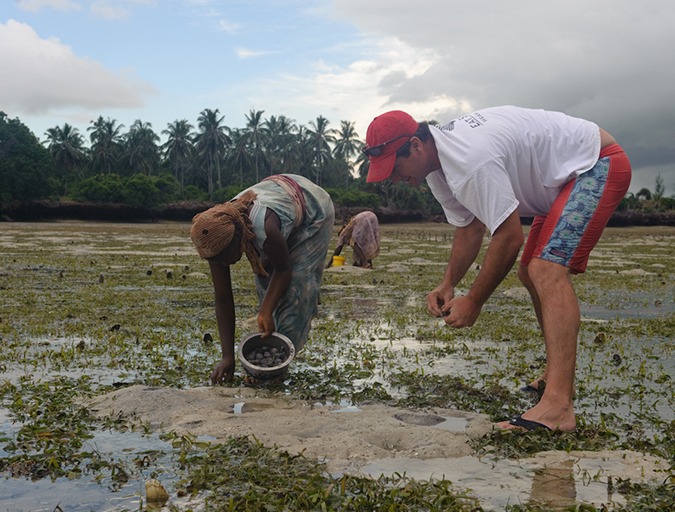
Responsibility
Social oysters: Aquaculture inspiring communities
Two New England shellfish producers are furthering their innovative social license initiatives, both in their hometowns and in food-insecure regions overseas. Island Creek Oysters and Matunuck Oyster Farm have become admirable aquaculture ambassadors.
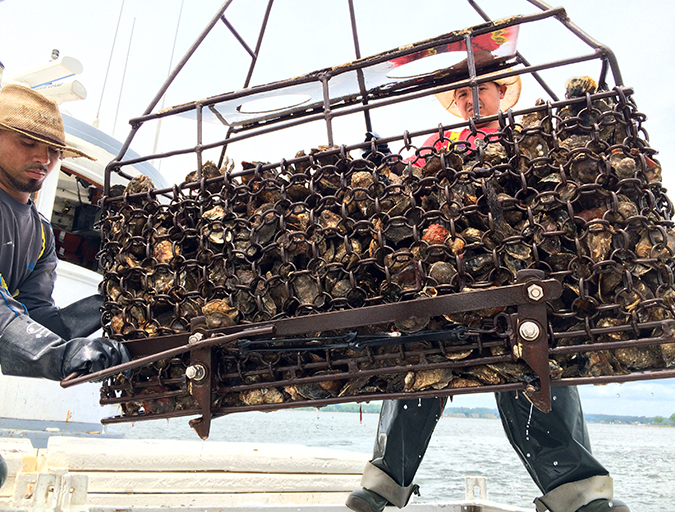
Intelligence
As ocean temperatures rise, so too will vibrio outbreaks
A study using a half-century of data has linked climate change and warming sea temperatures with an increase in illnesses from the common vibrio bacteria. Shellfish growers, fighting a particularly virulent strain of Vibrio parahaemolyticus, are changing their harvest protocols.
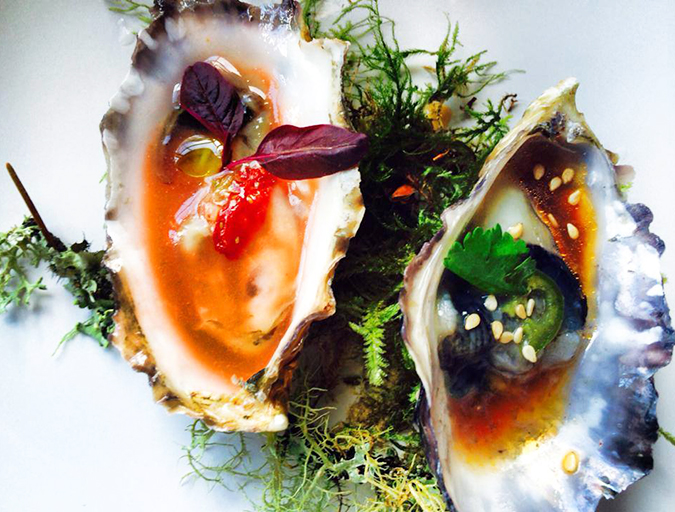
Intelligence
Cup size matters, but for oysters, branding matters more
To name an oyster is to give birth to a brand, essential to stand out in today’s raw bar scene. The briny bite-sized morsels are arguably seafood’s sexiest offerings, but a memorable moniker (and a quality product) is what keeps them on the menu.
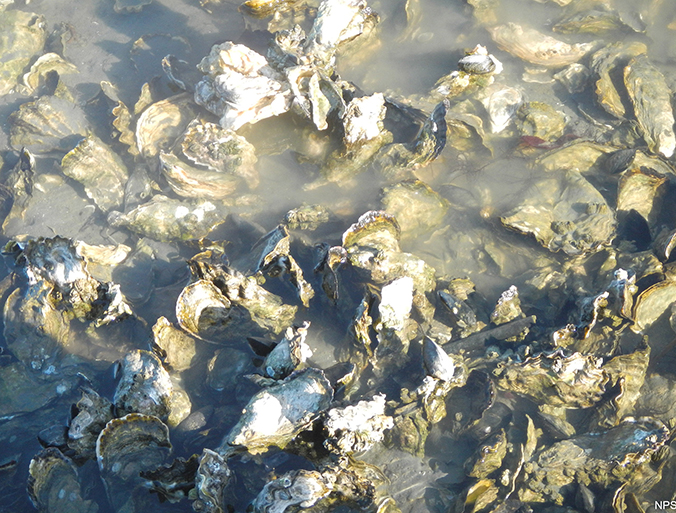
Responsibility
Two years after shutdown, California oyster farm remains a community hot-button
When one of California’s oldest oyster farms was shut down amid reports that it was degrading the environment, local observers took notice. Two years later, the case is still far from closed in the eyes of the farm’s supporters and its critics.


